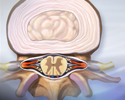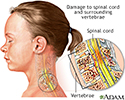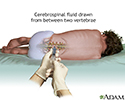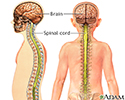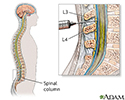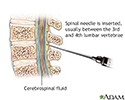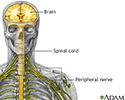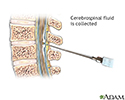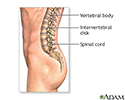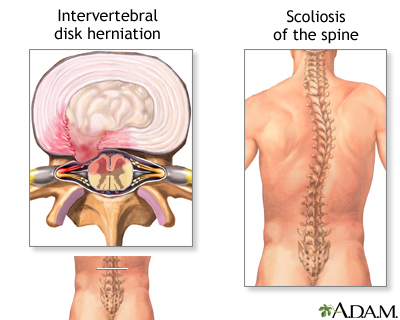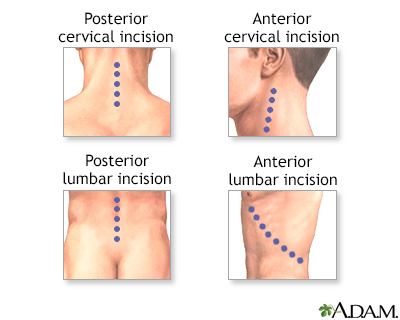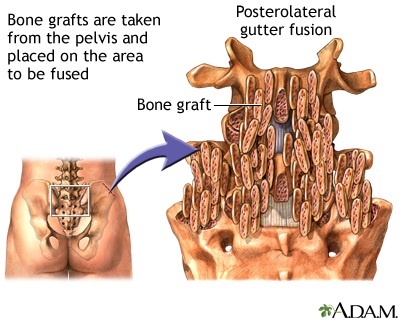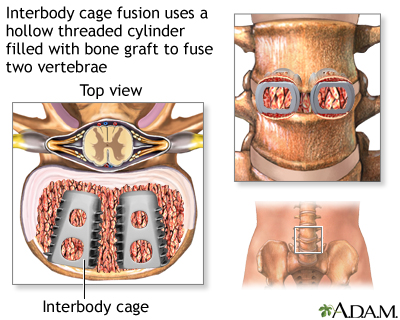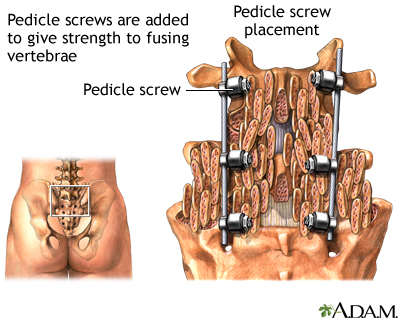Spinal injury
Spinal cord injury; SCIThe spinal cord contains the nerves that carry messages between your brain and the rest of the body. The cord passes through your neck and back. A spinal cord injury is very serious because it can cause loss of movement (paralysis), function, and sensation below the site of the injury.
Spinal stenosis - Animation
Spinal stenosis
Animation
Spinal cord injury
A severe spinal cord injury often causes loss of feeling and paralysis, the loss of movement and voluntary control over the muscles in the body. Spinal cord damage also causes loss of reflex function below the point of injury interrupting bodily functions such as breathing, bowel control, and bladder control. In the event of a spinal injury prompt medical attention can help to minimize further spinal cord damage.
Spinal cord injury
illustration
Lumbar puncture (spinal tap)
A lumbar puncture, or spinal tap, is a procedure to collect cerebrospinal fluid to check for the presence of disease or injury. A spinal needle is inserted, usually between the third and fourth lumbar vertebrae in the lower spine. Once the needle is properly positioned in the subarachnoid space (the space between the spinal cord and its covering, the meninges), pressures can be measured and fluid can be collected for testing.
Lumbar puncture (spinal tap)
illustration
Central nervous system
The central nervous system is made up of the brain and spinal cord. The brain functions to receive nerve impulses from the spinal cord and cranial nerves. The spinal cord contains the nerves that carry messages between the brain and the body. Spinal cord injury can occur when there is damage to the cells within the spinal cord or when the tracts of nerves that run up and down the spinal cord are severed.
Central nervous system
illustration
CSF smear
Cerebral spinal fluid (CSF) is a clear fluid that circulates in the space surrounding the spinal cord and brain. CSF protects the brain and spinal cord from injury by acting like a liquid cushion. CSF is usually obtained through a lumbar puncture (spinal tap). During the procedure, a needle is inserted usually between the 3rd and 4th lumbar vertebrae and the CSF fluid is collected for testing.
CSF smear
illustration
Lumbar puncture
Cerebral spinal fluid (CSF) is a clear fluid that circulates in the space surrounding the spinal cord and brain. CSF protects the brain and spinal cord from injury by acting like a liquid cushion. CSF is usually obtained through a lumbar puncture (spinal tap). During the procedure, a needle is inserted usually between the 3rd and 4th lumbar vertebrae and the CSF fluid is collected for testing.
Lumbar puncture
illustration
Nervous system
Peripheral Neuropathy is not a distinct disease, but the manifestation of many conditions that damage the peripheral nerves (nervous tissue other than the brain and spinal cord). Symptoms depend on whether sensory nerves (the nerves that transmit sensory information from the body to the brain and spinal cord) or motor nerves (the nerves that transmit impulses from the brain and spinal cord to the body) are affected. If the sensory nerves are damaged, sensation may be diminished, lacking or abnormal. Damaged motor nerves impair movement or function. Peripheral neuropathy may be caused by direct or indirect injury, or by a systemic cause such as a metabolic disorder.
Nervous system
illustration
CSF chemistry
Cerebrospinal fluid (CSF) is a clear fluid that circulates in the space surrounding the spinal cord and brain. CSF protects the brain and spinal cord from injury by acting like a liquid cushion. CSF is usually obtained through a lumbar puncture (spinal tap). During the procedure, a needle is inserted usually between the third and fourth lumbar vertebrae and the CSF fluid is collected for testing.
CSF chemistry
illustration
Spinal fusion - series
Presentation
Spinal cord injury
A severe spinal cord injury often causes loss of feeling and paralysis, the loss of movement and voluntary control over the muscles in the body. Spinal cord damage also causes loss of reflex function below the point of injury interrupting bodily functions such as breathing, bowel control, and bladder control. In the event of a spinal injury prompt medical attention can help to minimize further spinal cord damage.
Spinal cord injury
illustration
Lumbar puncture (spinal tap)
A lumbar puncture, or spinal tap, is a procedure to collect cerebrospinal fluid to check for the presence of disease or injury. A spinal needle is inserted, usually between the third and fourth lumbar vertebrae in the lower spine. Once the needle is properly positioned in the subarachnoid space (the space between the spinal cord and its covering, the meninges), pressures can be measured and fluid can be collected for testing.
Lumbar puncture (spinal tap)
illustration
Central nervous system
The central nervous system is made up of the brain and spinal cord. The brain functions to receive nerve impulses from the spinal cord and cranial nerves. The spinal cord contains the nerves that carry messages between the brain and the body. Spinal cord injury can occur when there is damage to the cells within the spinal cord or when the tracts of nerves that run up and down the spinal cord are severed.
Central nervous system
illustration
CSF smear
Cerebral spinal fluid (CSF) is a clear fluid that circulates in the space surrounding the spinal cord and brain. CSF protects the brain and spinal cord from injury by acting like a liquid cushion. CSF is usually obtained through a lumbar puncture (spinal tap). During the procedure, a needle is inserted usually between the 3rd and 4th lumbar vertebrae and the CSF fluid is collected for testing.
CSF smear
illustration
Lumbar puncture
Cerebral spinal fluid (CSF) is a clear fluid that circulates in the space surrounding the spinal cord and brain. CSF protects the brain and spinal cord from injury by acting like a liquid cushion. CSF is usually obtained through a lumbar puncture (spinal tap). During the procedure, a needle is inserted usually between the 3rd and 4th lumbar vertebrae and the CSF fluid is collected for testing.
Lumbar puncture
illustration
Nervous system
Peripheral Neuropathy is not a distinct disease, but the manifestation of many conditions that damage the peripheral nerves (nervous tissue other than the brain and spinal cord). Symptoms depend on whether sensory nerves (the nerves that transmit sensory information from the body to the brain and spinal cord) or motor nerves (the nerves that transmit impulses from the brain and spinal cord to the body) are affected. If the sensory nerves are damaged, sensation may be diminished, lacking or abnormal. Damaged motor nerves impair movement or function. Peripheral neuropathy may be caused by direct or indirect injury, or by a systemic cause such as a metabolic disorder.
Nervous system
illustration
CSF chemistry
Cerebrospinal fluid (CSF) is a clear fluid that circulates in the space surrounding the spinal cord and brain. CSF protects the brain and spinal cord from injury by acting like a liquid cushion. CSF is usually obtained through a lumbar puncture (spinal tap). During the procedure, a needle is inserted usually between the third and fourth lumbar vertebrae and the CSF fluid is collected for testing.
CSF chemistry
illustration
Spinal fusion - series
Presentation
Spinal injury
Spinal cord injury; SCIThe spinal cord contains the nerves that carry messages between your brain and the rest of the body. The cord passes through your neck and back. A spinal cord injury is very serious because it can cause loss of movement (paralysis), function, and sensation below the site of the injury.
Spinal injury
Spinal cord injury; SCIThe spinal cord contains the nerves that carry messages between your brain and the rest of the body. The cord passes through your neck and back. A spinal cord injury is very serious because it can cause loss of movement (paralysis), function, and sensation below the site of the injury.
Review Date: 4/24/2023
Reviewed By: C. Benjamin Ma, MD, Professor, Chief, Sports Medicine and Shoulder Service, UCSF Department of Orthopaedic Surgery, San Francisco, CA. Also reviewed by David C. Dugdale, MD, Medical Director, Brenda Conaway, Editorial Director, and the A.D.A.M. Editorial team. Editorial update 10/16/2023.

